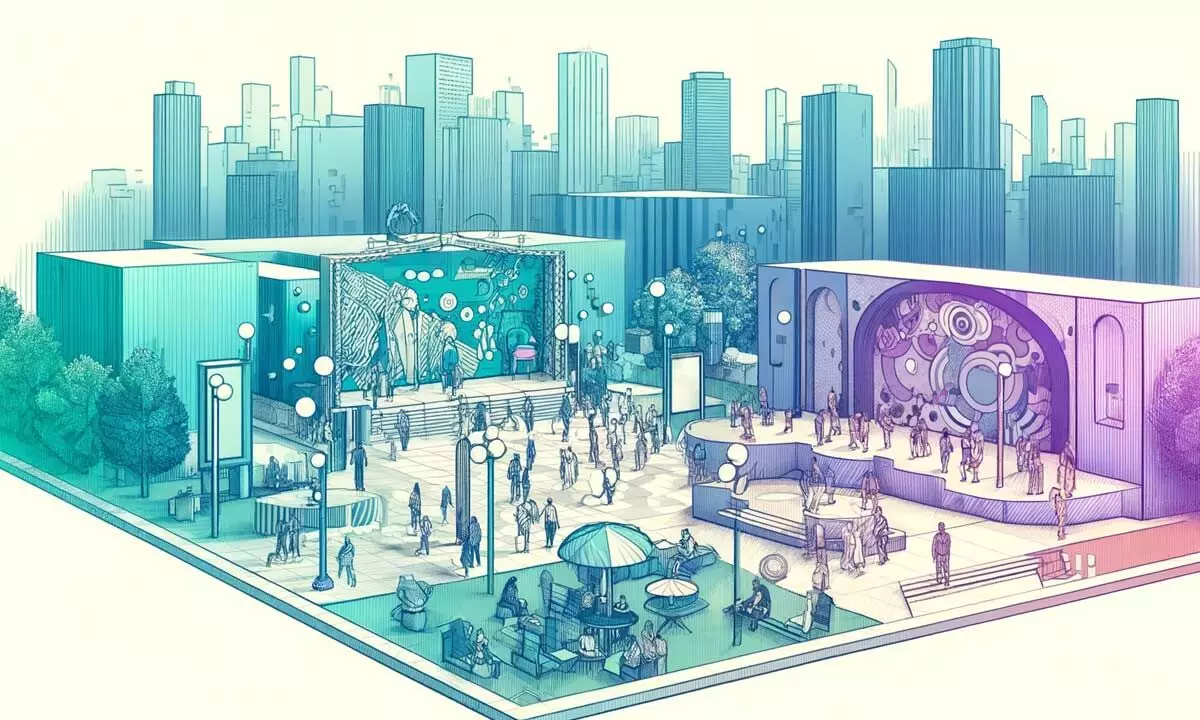Live
- Experience the Best Human Hair Extensions with Gemeria
- Advanced F&O strategies for experienced investors - Straddles, strangles, Iron condors
- Dr. Harikiran Chekuri suggests that a hair transplant can help regain hair growth to reclaim confidence and self-esteem
- Chandrababu Praises Mahayuti Alliance for Maharashtra Assembly Elections win
- Where Drops Define Destiny: The Elite Chronicles of IPC's 30th Revolution
- Aahwahan Foundation Launches “Sapnon Ke Sawari” Initiative to Empower Differently-Abled Individuals
- Are Market-linked Plans Suitable for First-time Investors?
- Vijay to host farmers, landowners who provided venue for TVK’s first meet in TN
- Bengal bypolls: Trinamool candidates declared elected from Naihati, Sitai; leading in other four seats too
- Black Friday 2024: Amazon, Samsung, Sony Discounts Unveiled; More Brands To Join
Just In

Public art is a powerful medium that transcends mere aesthetics; it serves as a reflection of the community it inhabits, offering a visual narrative that resonates with the people and the place
Public art is a powerful medium that transcends mere aesthetics; it serves as a reflection of the community it inhabits, offering a visual narrative that resonates with the people and the place. When public art is infused with local culture, it becomes more than just a decorative element; it evolves into a symbol of identity, history, and shared values. Integrating local culture into public art is crucial for fostering a sense of belonging, preserving cultural heritage, and enriching the community's social fabric.
Creating a Sense of Belonging
One of the most significant benefits of integrating local culture into public art is the creation of a sense of belonging. Public art that resonates with the cultural identity of a community helps individuals feel connected to their surroundings. When people see their stories, traditions, and values represented in public spaces, it reinforces their connection to the place they live in. This sense of belonging fosters community pride and encourages people to take ownership of their environment, leading to stronger, more cohesive communities.
For example, murals that depict local legends, historical events, or everyday life scenes unique to the community can evoke a shared sense of identity. These visual representations serve as reminders of the community's roots and collective experiences, helping to strengthen the social ties that bind individuals together. In this way, public art becomes a unifying force, bringing together diverse groups of people under a common cultural umbrella.
Preserving Cultural Heritage
Integrating local culture into public art also plays a vital role in preserving cultural heritage. As societies evolve, there is a risk that traditional practices, stories, and customs may be forgotten. Public art provides a platform to keep these cultural elements alive, ensuring that they are passed down to future generations. By embedding cultural narratives into public art, communities can safeguard their heritage in a way that is both accessible and engaging.
Public art that incorporates traditional symbols, languages, or artistic techniques can serve as a living archive of cultural heritage. For instance, sculptures that reflect indigenous craftsmanship or installations that incorporate local folklore contribute to the preservation of cultural diversity. These artworks not only educate the public about the community's history and traditions but also inspire a sense of continuity, reminding people of their cultural roots.
Moreover, public art that celebrates local culture can also challenge the homogenization of urban spaces. In a globalized world where cities often start to look alike, public art rooted in local culture can help maintain the distinctiveness of a place. This uniqueness not only attracts visitors but also instills a sense of pride among residents, who can see their culture represented and celebrated in public spaces.
Enriching Social Fabric
Public art has the potential to enrich the social fabric of a community by fostering dialogue, encouraging participation, and promoting cultural exchange. When local culture is integrated into public art, it invites conversation about shared histories, values, and identities. These conversations can bridge generational and cultural gaps, creating opportunities for understanding and collaboration.
Art installations that involve community participation, such as collaborative murals or public sculptures, can be particularly effective in enriching the social fabric. These projects encourage people to contribute their ideas, skills, and perspectives, resulting in artworks that truly reflect the community's diversity. The process of creating public art becomes as important as the final product, as it brings people together, fosters collaboration, and strengthens social bonds.
Furthermore, public art that reflects local culture can promote cultural exchange by introducing residents and visitors to different aspects of the community's heritage. For example, a public art piece that incorporates elements of traditional dance, music, or storytelling can serve as a cultural bridge, connecting people from different backgrounds and fostering mutual respect and appreciation.
Integrating local culture into public art is not just a matter of aesthetics; it is a powerful tool for community building, cultural preservation, and social enrichment. By reflecting the unique identity of a place, public art can create a sense of belonging, safeguard cultural heritage, and foster a vibrant, cohesive community. As cities and towns continue to evolve, it is essential to recognize the importance of local culture in shaping public spaces that are not only beautiful but also meaningful and reflective of the people who inhabit them.
(The author is Director and Principal Artist, East Craft Designs Pvt. Ltd.)

© 2024 Hyderabad Media House Limited/The Hans India. All rights reserved. Powered by hocalwire.com







